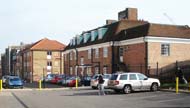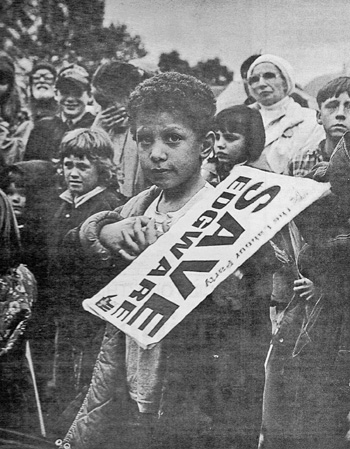Acute
In 1838 the Hendon Board of Guardians opened a new workhouse - Redhill House - on a 20 acre site at Burnt Oak on the north side of Edgware Road. A Union School was built in 1859 to the northwest of the workhouse for 150 pauper children and, in 1865, an infirmary was erected on adjacent land (in 1890 padded cells were added for lunatic inmates).
In 1924, rather than an extension being added to the Redhill infirmary, work began on a new building behind the School. The Hendon Union Infirmary opened in 1927 with 175 beds. It was one of the last workhouse infirmaries to be built.
The central administrative block had 2-storey pavilion ward blocks on either side. Other buildings housed a receiving ward, an operating theatre, a Nurses' Home and a mortuary. There was also a boiler house and a gate lodge.
In 1930 Middlesex County Council took over administration of the workhouse, which became the Redhill Public Assistance Institution; its infirmary was renamed Redhill Hospital. The former Union School became Redhill Lodge, a men's home. In 1931 the Hospital was renamed the Redhill County Hospital.
Between 1936 and 1938 the Hospital was greatly extended, with a 60-bed maternity unit and a 329-bed medical block being added. It was also responsible for the administration of the Bushey Maternity Hospital, which opened in 1938.
In 1948 it joined the NHS and was renamed Edgware General Hospital, coming under the control of the Hendon Group Hospital Management Committee. This Group also included the Bushey Maternity Hospital, Hendon District Hospital, Colindale Hospital, Hendon Isolation Hospital, Roxbourne Hospital, Oxhey Grove, Stanmore Cottage Hospital, Harrow Chest Clinic and Edgware Chest Clinic (all of which have now closed).
By 1954 the Hospital had 651 beds.
In 1964 it had 718 beds but, because of a nursing staff shortage, 86 (11%) had to be closed. In the same year a new extension for the Out-Patients department opened, which contained nine consulting rooms, pathology laboratories and a minor operations suite. There was also a self-contained ophthalmic unit with 26 beds and an eye casualty department. Work began on five new operating theatres with a recovery ward and a plaster room. In 1965 a new chapel was built at the cost of £8000 and a Library initiated, which was based in the former Board Room.
By 1982 the Hospital had 600 beds, dealing mainly with acute patients.
In 1994 a public consultation was held concerning the future of the Hospital. Despite public resistance, it closed in 1997.
Present status (February 2008)
The former Union School and much of the Infirmary have been demolished. The central administration block remains.
In 1998 the then Health Minister, Alan Milburn, agreed to the building of a new hospital on the site.
The Edgware Community Hospital, with mainly out-patient facilities, opened in 2005, replacing the General Hospital. It had cost £38m - double the original proposed budget. To raise funds for the new hospital building programme, the rest of the site was sold to the developers Taylor Woodrow to build 289 homes.
The original administration blocks survive at the north end of the site.


The main entrance to the new Hospital off Burnt Oak Broadway.

3rd November, 1994 Demonstrators of all ages gather under Saturday's steel-grey skies.
Public demonstrations in support of keeping the Hospital open came to no avail and the authorities closed it a few years later.
(Photograph by courtesy of Dale Annous, shown here in the centre of the crowd in Silk Stream Park)
www.a2a.org.uk
www.barnetpct.nhs.uk
www.british-history.ac.uk
www.workhouses.org.uk
Return to home page